An advanced explorer with an excellent technical pedigree that’s pursuing aggressive exploration and appraisal activity with respect to its Tennant Creek acreage in conjunction with Evolution Mining.
| Corporate Details | 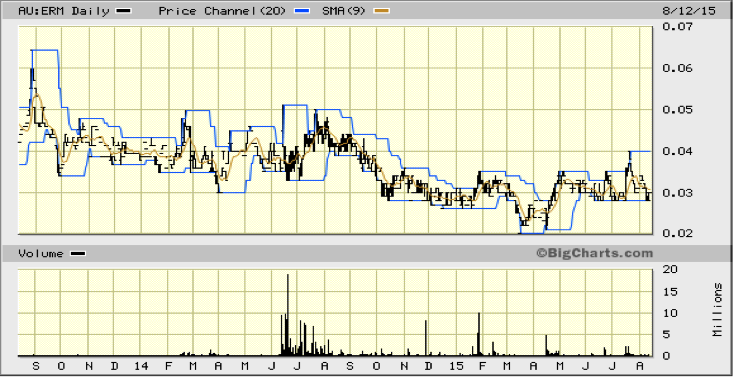 |
| Status: Advanced Explorer | |
| Size: Small Cap | |
| Commodity Exposure: Gold | |
| Share Price: $0.03 | |
| 12-month Range: $0.021 – $0.044 | |
| Shares: 377m, Options: 2.1m | |
| Top 20: 61% | |
| Net Cash: $3.2m | |
| Market Value: $11m |
| Key Parameters | Rating (✓out of 5) | Quarterly Statistics |
| Management Quality | ✓✓✓✓✓ | Q2 2015 Exploration Spend: $0.776m |
| Financial Security | ✓✓✓✓✓ | Q2 2015 Administration Spend: $0.280m |
| Project Quality | ✓✓✓✓✓ | Exploration Spend 73%, Admin. Spend 27% |
| Exploration / Resource Potential | ✓✓✓✓✓ | Q3 2015 Forecast Exploration Spend: Nil |
| Project Risk | ✓✓✓✓✓ | Q3 2015 Forecast Admin. Spend: $0.3m |
We introduced Emmerson Resources to our Portfolio during December 2010, based on our long-standing belief in the company’s high-grade, gold-copper Tennant Creek acreage package in the Northern Territory. We’ve maintained confidence in the company’s ability to ‘crack the code’ with respect to the geology of Tennant Creek, with the ultimate goal of production status. The 2014 joint venture tie-up with Evolution Mining (ASX: EVN) has reaffirmed our confidence in the overall story.
One of the company’s biggest attractions has been technological. Emmerson utilises a technique that is able to clearly identify fresh gold-copper targets that have a strong chance of being mineralised. Within the Tennant Creek context this means the identification of mineralisation-bearing host ironstones. The use of HeliTEM surveys has allowed for the identification of extensions to prospective mine corridors, thus expanding mineralized trends well outside of areas previously defined by magnetic surveying alone.
We believe there is a fundamental lack of broader market appreciation of the significance of the farm-out/joint venture deal with Evolution Mining (ASX: EVN). The deal has huge implications for a company of Emmerson’s modest size, with Evolution investing almost $29 million in both Tennant Creek exploration and Emmerson itself, over the next five years. Evolution’s commitment reinforces our long-held view on the vast resource potential of Emmerson’s Tennant Creek portfolio.
Recent Activity
Tribute Mining at Edna Beryl
Emmerson announced this week that it had signed a “small mines” Tribute Agreement with Edna Beryl Mining Company (EBMC), which will allow EBMC to commence permitting and if successful, undertake mining of Emmerson’s high-grade Edna Beryl gold deposit, situated within its Northern Project Area.
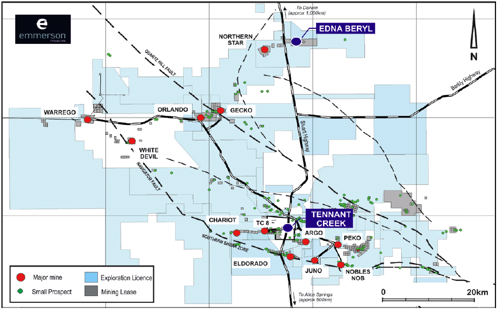
EBMC are narrow-vein mining specialists, with more than 50 years’ of combined mining and mine management experience. EMBC’s principals are very familiar with the Tennant Creek Mineral Field, having started their careers at the White Devil gold mine and successfully completed similar small-scale underground mining projects at Rising Sun and New Hope.
EBMC also has prior underground experience at Edna Beryl, having been involved with exploratory shaft sinking and ore extraction under previous owners Giants Reef Mining, producing approximately 410 ounces of gold between 2004 and 2005 from the upper mineralised pod. EBMC intend to commence mining as soon as all statutory requirements are met.
Edna Beryl was discovered by prospectors during 1935 and was mined via underground during the 1940s & 1950s to a maximum depth of approximately 50 metres. Production up until 1952 was reportedly 2,700t of ore at an exceptional grade of 53g/t gold.
More recent exploration within the Edna Beryl area between 1996 and 2000 by Giants Reef Mining outlined additional high-grade gold mineralisation below the historic workings, resulting in an estimate being reported in 1998 by independent consultants in accordance with 1998 JORC. Whilst this estimate does not meet the minimum reporting requirements under the current 2012 JORC Code, Emmerson considers the Edna Beryl mineralisation to constitute a conceptual exploration target of between 5,000t and 10,000t, with a likely grade of 20 – 30 g/t gold.
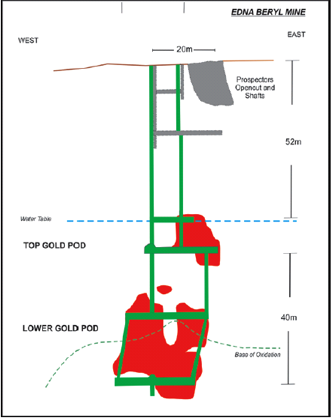
So why is this important? Well, the Tribute Agreement with EBMC provides Emmerson with a totally risk-free, near-term income stream from what is essentially a non-core asset. And there are more non-core assets that could also be monetized in this manner. The resumption of mining activity within the Tennant Creek Mineral Field is in itself an important development and will help supplement the company’s cash reserves and provide further opportunities to gain access to these historic, high-grade mines for near-mine exploration. Some of the most significant mines within the mineral field, such as White Devil, were discovered from similar strategies.
2015 Field Season Underway
Emmerson’s 2015 exploration program is underway and fully-funded by its joint venture partner, Evolution Mining. Activity is focused predominantly on the Eastern Project Area (EPA) within the Tennant Creek Mineral Field (TCMF).
The work has included a major 18,000-metre infill RAB drilling program at Emmerson’s Billy Boy prospect, with the aim being to sample the regolith/bedrock beneath the sand cover, targeting the best gold, copper and bismuth anomalies ahead of later testing by either RC or diamond drilling.
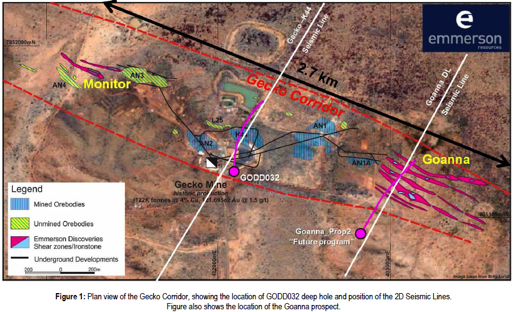
Encouragingly, results from the RAB program have successfully identified new massive iron alteration that typically hosts high-grade gold mineralisation within the TCMF. Furthermore, two of the four planned diamond drill-holes have also been completed and they have successfully verified the underlying geology, in particular the presence of the “hematite shale” horizon that is typically associated with high-grade gold mineralisation at most major deposits within the TCMF.
Samples from the RAB drilling program have been dispatched to the assay laboratory, whilst core logging and sampling is underway on the diamond drilling program. Based on the success of the RAB drilling, further holes are planned for Billy Boy as the diamond drilling continues.
In addition, Emmerson has made encouraging progress with respect to its deep-drilling program at Tennant Creek. Diamond drill-hole GODD032 is being co-funded as part of the Northern Territory’s “Creating Opportunities for Resources Exploration” (CORE) initiative and will be drilled to a planned total depth of 1,200 metres.
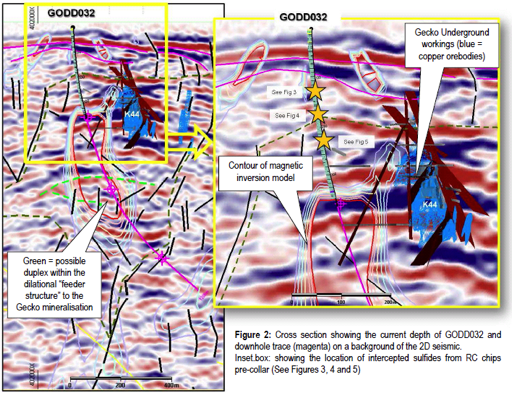
Encouragingly, the pre-collar to this deep hole has unexpectedly intersected multiple zones of copper sulphide mineralisation associated with quartz – chlorite veins, which is highly analogous to the recently discovered Goanna mineralization, which lies around 800 metres to the east. We understand that this represents a new zone of mineralisation despite it lying close to the existing mine. The apparent reason this has not been discovered by previous explorers is that it is non-magnetic and not the traditional magnetite ironstone style – rather it is analogous to the Goanna discovery where the copper is in quartz-chlorite veins.
Further infill drilling is required, as there are potentially important economic implications in terms of adding additional copper resources close to the existing mine development. Samples have been dispatched for analysis.
The drill hole has now switched to diamond core and is progressing towards the deeper target zones. The aim of the hole is to assist in validating the new geological and structural interpretation based on the recent 2D seismic traverse, as well as testing for gold mineralization around 400 metres beneath the historic underground Gecko copper workings.
Upcoming Activity
Emmerson and its partner, Evolution Mining, have agreed to an aggressive 28,000-metres drilling program for the September quarter that will involve the drill-testing of a variety of important gold targets. The work will comprise:
- 12,000 metres of regional greenfields RAB drilling over a number of targets within the Eastern Project Area (EPA) – designed to assist in developing drill-targets along a newly-discovered shear zone, where prospectors have found gold nuggets and where the recent aeromagnetic survey has indicated the presence of buried ironstones
- 12,000 metres of RC drilling spread across newly-identified “off hole” magnetic gold targets at Chariot and three new greenfield targets within the EPA
- 4,000 metres of diamond drilling to test a recently-identified “off-hole” magnetic target at Chariot East and to further test two high-calibre, buried ironstone targets within the EPA. These targets have been generated by a new predictive-targeting model where key geological, geochemical and geophysical attributes are strongly correlated with the known large deposits in Tennant Creek. Modeling suggests these targets host all the attributes of much larger deposits and have been overlooked in prior programs.
Project Overview
Emmerson’s 100%-owned EPA encompasses around 500 sq km and is predominantly covered by sand and is largely unexplored. Systematic work by Emmerson over a number of years has dramatically changed the exploration model, leading directly to the discoveries at Goanna and Monitor during 2011/12. The copper and gold within these prospects is associated with hematite ironstones and/or quartz vein arrays, constituting a new style of mineralisation and the first new discoveries within the TCMF for over a decade.
The EPA fits within this new style, as it is weakly magnetic and prospective for the gold-hematite ironstone association. Further supporting evidence is evident within the general area where one of Tennant Creek’s highest grade deposits – the historical Nobles Nob mine – produced around 2Mt at an average recovered grade of 17.3g/t gold (with some zones in excess of 124g/t gold), with the highest grades associated with hematite ironstone.
The area outside of the current drilling program encompasses around 400 sq km, so given the immediate success at Billy Boy the balance of the project area will be explored in a similar manner. The strategy involves using recent geological interpretations based on high-resolution magnetic surveying to define broad areas of interest – with subsequent RAB drilling to pinpoint mineralisation, then follow-up RC/diamond drilling to test the depth potential of the mineralisation.
During H2 2014, 4,200 line km of high-resolution magnetics and radiometrics was completed within the EPA (refer to graphic above), providing an excellent framework for assessing the undercover geology and structure, along with the successful identification of new, weakly-magnetic ironstone.
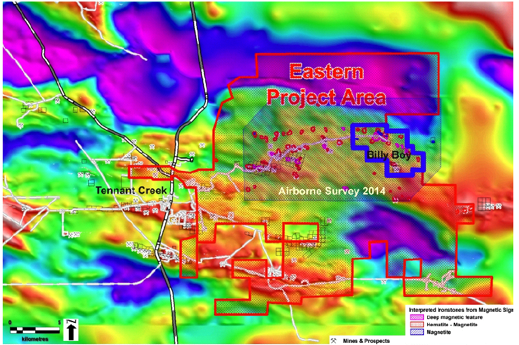
In parallel, a large regional RAB drilling program was conducted over the Billy Boy Mining Leases on 1.7km-spaced lines, aimed at geochemically sampling the bedrock and tracing back to source some gold-jasper nuggets returned by local prospectors. The anomalous geochemistry from this program occurs along major structures, in association with the hematite shale formation (an important element in the joint venture’s new exploration model) and in some cases, across contiguous lines.
Four trial lines of seismic reflection were completed over known mines. Whilst the results of this survey are still confidential, the initial interpretations are providing new insights into the controls on the TCMF mineralisation. Specifically, the survey detected both the presence and orientation of the structures and conduits that are responsible for channeling the mineralising fluids. It is anticipated this survey will assist in better targeting the gold zones beneath some of the copper at such deposits as Gecko.
Similarly, Emmerson has been working with respected specialists on targeting methodology in an effort to identify statistically robust parameters of the known deposits in the TCMF. To date some 237 predictive maps have been produced, which constitute the various elements of the exploration model plus empirical data derived from surface geochemistry and drill holes.
Preliminary testing of this model gave a Weights of Evidence success rate of 95.92% in predicting known deposits and 99.83% for the Logistic Regression model – and further fine tuning is currently underway. It is anticipated that this will assist in identifying new areas with similar geological characteristics to the known major deposits and prospects that have all the elements but have not been effectively explored.
Based on Emmerson’s belief that the metal zonation at Gecko and Goanna indicates potential for a sizeable gold zone underlying the high-grade copper mineralization, this will be an exciting program. The regional seismic survey will provide the first deep seismic profile through the entire TCMF. This survey has the potential to rewrite the structural and geological framework of the field and provide important regional context to reinvigorating the discovery of a new generation of gold and copper deposits.
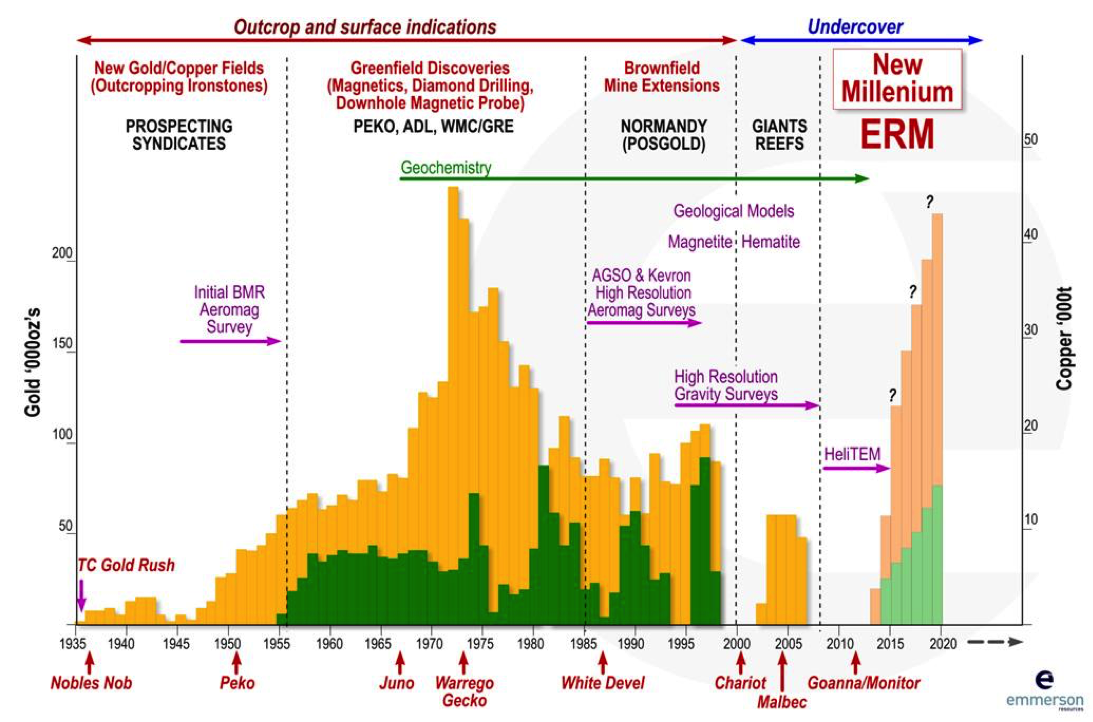
Evolution Minerals Farm-in
Under the terms of the deal announced back in mid-2014, Evolution can sole-fund exploration expenditure worth $15 million over a three-year period in order to earn a 65% stake in Emmerson’s 2,500 sq km Tennant Creek project area. Evolution can then spend a further $10 million minimum over a further two-year period to earn an additional 10% stake in the Tennant Creek project area, taking its total stake to 75%.
Evolution also subscribed to a placement of 49.144 million Emmerson shares at a price of $0.0381 each that raised $1.872 million, whilst Emmerson also received approximately 2.5 million Evolution shares at an issue price of $0.7986 per share (currently trading at $1.02). This has boosted Emmerson’s cash reserves and investments to around $5.7 million.
The major consequence of the tie-up with Evolution is that a major ramp-up in field activity is underway, hopefully accelerating the company’s transition from advanced exploration status to that of a producer. The aim is to achieve this through aggressive near-mine drilling programs aimed at growing the existing JORC-compliant resource base, combined with regional exploration work. Exploration activity is drawing upon Evolution’s vast development and exploration expertise, but is managed and operated by Emmerson.
Summary
We’ve been following Emmerson Resources and its Tennant Creek exploration campaign for some time now. The Tennant Creek mineral field has in fact produced more than 5.5 M ounces of gold and 470,000 tonnes of copper over its history, making it one of the highest-grade goldfields within Australia. Emmerson has consolidated 95% of the mineral field, where amazingly just 8% of the historical drilling has penetrated below 150 metres depth. Some of the most prospective rocks in the field lie hidden beneath recent cover.
The 2015 exploration program is testing interesting targets such as Billy Boy, which represent outstanding, large scale, multi-element geochemical anomalies. In addition, early-stage results from the application of new technology such as the recent seismic survey appear promising in terms of enhancing the company’s capacity to explore at depth. These are allowing Emmerson to test for high-grade gold mineralization beneath the some of the copper zones at the Gecko and Goanna deposits.
The tie-up with Evolution Mining provides shareholders with financial security, technical expertise, a high level of exploration activity, a potentially accelerated timeline to production and also minimal dilution. Exploration activity will draw upon Evolution’s vast development and exploration expertise, but will be managed and operated by Emmerson. We therefore retain our Speculative Buy recommendation on Emmerson Resources around current price levels for those investors without existing exposure to the stock.







